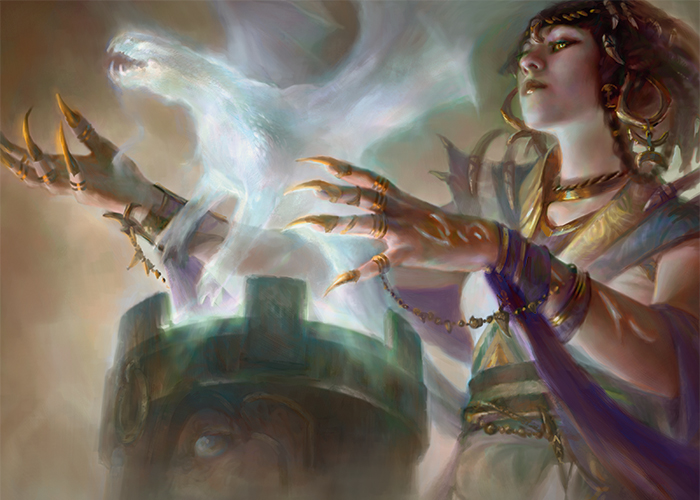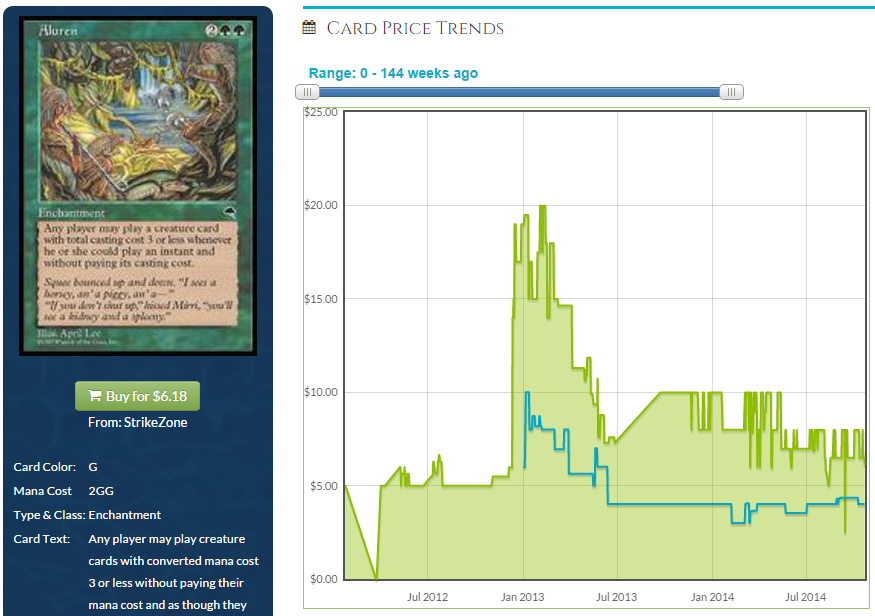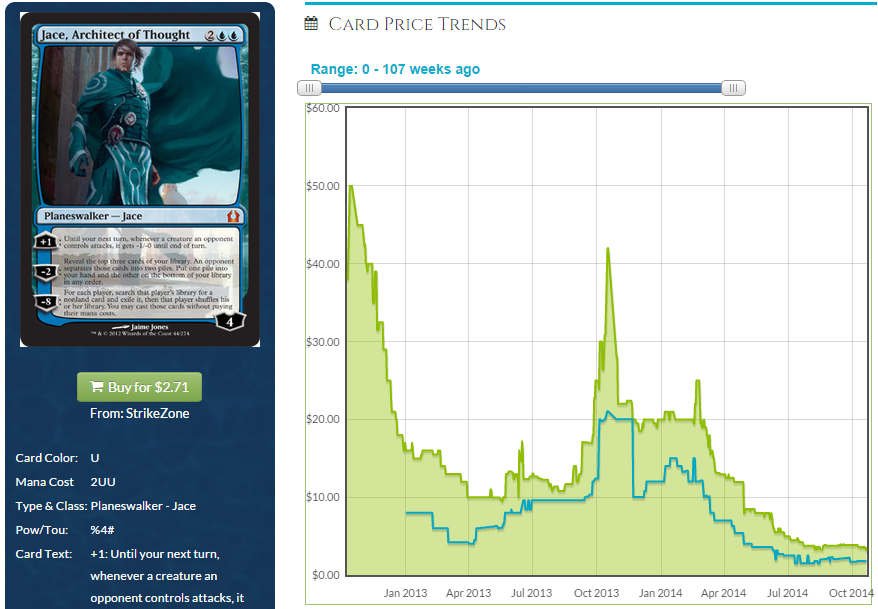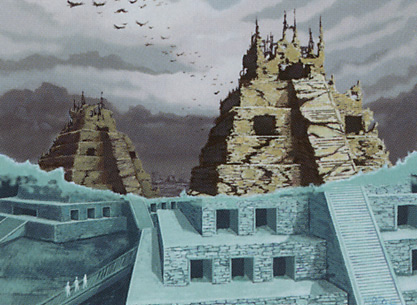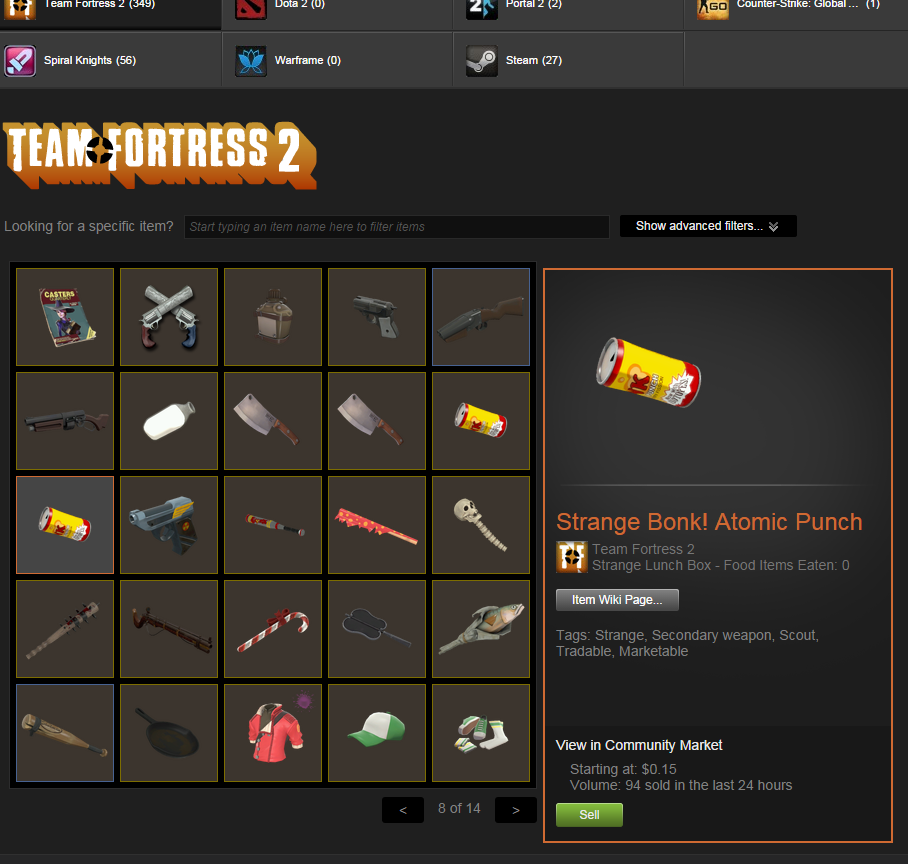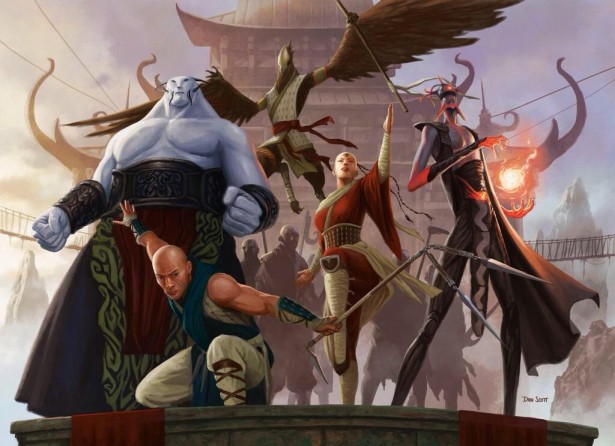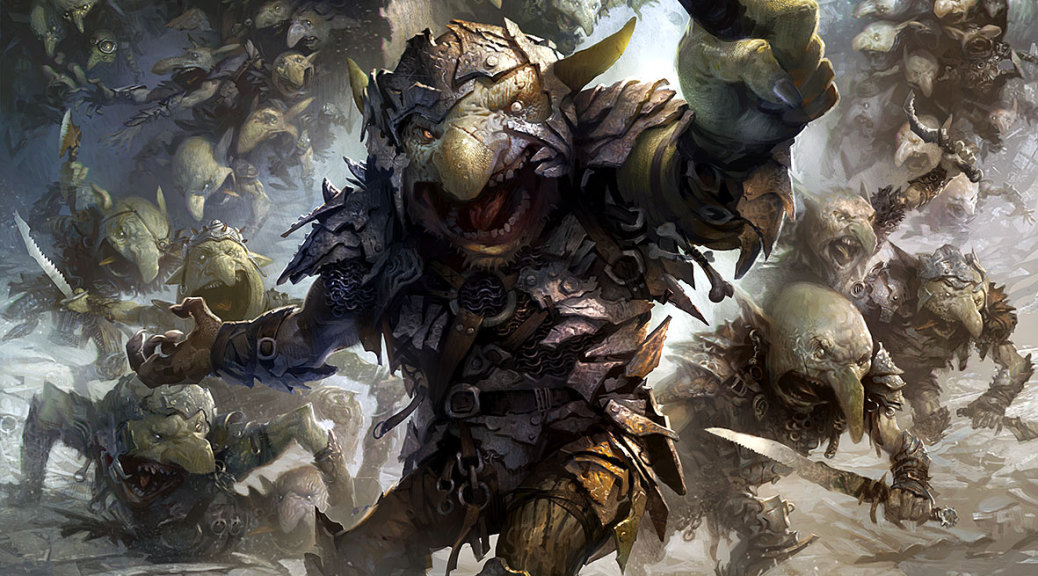By: Travis Allen
Perhaps the most common question I’m asked is “when should I sell [some card]?” It’s a reasonable question. You’ve got spare copies that you’ve been saving for a rainy day, say Sylvan Caryatid, and you want to know when you should get rid of them. The goal is simple enough to understand; maximize your profit while avoiding unnecessary risk. While there’s no clear algorithm that will tell you exactly when to sell, there is a heuristic I use when making the decision myself. I’ll provide you with my methodology today. First, two mistakes that are easy for anyone to stumble into when making decisions about selling cards.
One of the biggest traps of speculating on Magic cards, or even more general investment avenues such as the stock market, is not knowing when to dump a good. There are a few psychological factors that play into this, such as the “sunk cost fallacy.” I can demonstrate this concept with an example from my own recent history. I purchased about $100 worth of Advent of the Wurms a ways back when they were still about $3. As it became clear they weren’t going break out and that I should out them while I could, I instead gripped onto them tighter, assuring myself that someone would definitely bust the card and I would make my money back. Because I had paid the $3 each for them, I didn’t want to sell them for less than that. Instead of taking the $1.50 each or whatever it was I could have gotten for them, I instead held on, waiting until I could at least break even. Here we are today, with the best buylist for my thirty-some copies being $.25.
When you’re considering whether to sell cards, you must divorce your decision from the amount you originally paid for them. If the best time to sell is today, then you should sell today, regardless of what sort of profit or loss you’re looking at. For a better understanding of the topic, I recommend checking out the wiki page.
Another trap when speculating on Magic cards is greed, plain and simple. When Fist of Suns first spiked in early January copies went from $2 to $12. If you had been lucky enough to have some in your possession when the spike occurred, you should have rushed to market. If you were greedy you would have listed the cards for the full $12, hoping to extract maximum value from the sudden surge in demand. Over the span of weeks the price slowly dwindled with a lack of results. If you kept trying to squeeze as much out of them as you could you would have never actually sold any. The card has now settled at $5, which means that if you manage to sell your copies you’d see a much smaller return than if you had just listed them at $9 or $10 immediately after the spike and gotten another fool to buy in. Instead of quickly shipping cards during the wave of hype, being greedy and hoping for maximum profit would have ended up costing you a good $3-$5 profit per card.
Managing to get ahead of a price spike is an excellent feeling. Watching TCG sell out of Master of Waves while you stroke your twenty playsets that you got for $6/card would have been euphoric. Getting in ahead of the spike is only half the battle though. Knowing when to get rid of your copies for a profit can be even more difficult than guessing the next big thing.
Hype-driven spikes aren’t the only times where we fail to sell out when we should. Impending rotations, promises of reprints, and the recognition of price ceilings are all indicators of the time to sell being now. Let’s take a look at some things to keep in mind when considering whether you should sell your copies of a card.
Choo Choo! All Aboard the Hype Train!
When deciding whether you should sell a card, ask yourself if it just saw a massive spike in price. If the answer to that is yes, then you should almost definitely be selling. “But Travis, what if that snake alchemist brew ends up being tier one and blah blah blah.” No, stop it. If a card spiked, ship your copies fast and hard. Nearly every single time a card sees a huge jump due to a breakout performance the price drops significantly from its peak in a matter of days. Master of Waves dropped from a peak of $25(!) to $10 in about two weeks, even though the best possible scenario of Mono-Blue being a tier one deck materialized. Think about that.
Everything went exactly right for Master of Waves. He was a four-of mythic staple in a tier-one Standard deck that dominated the format for months, and still the $20+ price tag was unsustainable.
Take a look at the price graphs on Aluren. Or Boros Reckoner. Or Fist of Suns. They all drop-off from their frenzied height. Exceptions to this are few and far between, and shouldn’t be used as evidence not to sell during a hype phase.
Remember that we’re trying to be the best Bayesians we can be. A major part of that is not thinking absolutely, but rather probabilistically. If a $1 card hits $10 overnight, you have to think of the future in terms of probability. Which is more probable? That the card continues to climb past the $10, or it drops to half of that within a week? Well, which is more likely – that a $1 card has been so severely undervalued that the real price is north of $10, or that it’s really a $5-$6 card and the market just hasn’t corrected yet? 98% of the time it’s the latter. When a card sees a sudden meteoric rise, it’s simply so much more likely that the card drops significantly rather than continues to gain that it’s 100% right to sell. The one time you sell too early you won’t even have to feel bad, because the last nine times you sold out during the hype you made a killing while the card eventually bottomed out at half of the hype price.
Playability Saturation
Instead of seeing dramatic spikes, some cards experience slow and consistent growth. A good example here would be Jace, Architect of Thought. He bottomed out during the summer between Ravnica and Theros before jumping back into the spotlight after fall rotation. Aside from a very brief spike to $40+ (which may be a data problem; I don’t ever remember seeing him that high), he hung around $20-$25. This was absolutely the right time to sell. Some people may have held on hoping to break $30, but why would that have been a bad idea?
First we need to consider what formats care about a particular card. While Jace was doing excellent in Standard, his demand elsewhere was nearly nonexistent. Modern, Legacy, Vintage, EDH – nobody other than the Standard crew was looking for copies. Meanwhile, he was already all over the place in Standard. Mono-Blue was running multiple copies. Sphinx’s Revelation decks had the full playset almost without fail. Even off-the-wall brews had a few copies. At that time, I would say that Standard was saturated with JAoT.
There simply wasn’t any room left in Standard for Jace to see more play. Every deck that could possibly be interested in Jace already had them, and there was no other format placing demand on the card. There were only two realistic outcomes: the price sustains, or the price drops. Faced with those two options, you certainly want to be selling.
When you’re looking at a card you’re considering selling, ask yourself: how much more play could this see? How much more untapped demand could exist for this card? When you look at a card like Eidolon of Blossoms or some of the Theros gods, the potential seems huge. They’re powerful cards that could play well in both Standard and casual, and the prices are very low. There’s room to grow. However when you look at Elspeth, Sun’s Champion’s price tag of $32, do you still think the same thing? Do you realistically believe that there’s enough gas left in the tank for her to break $35 or $40? Have other fall set Standard-only mythics had price tags that high?
Consider what demand exists for the card. Think about how much play its seeing in the formats that may want it. Think about how much other cards from similar sets cost at their high point. Think about how much more the card could possibly rise. In a case such as Elspeth’s, the answer becomes clear. Yes, she could manage to eek out a few more dollars, but it’s considerably safer just taking the locked-in profit now and moving on to something with much more potential.
Hello and Goodbye
This factor is particularly salient today, only weeks after Khans release. Card prices are always high after a set release. They’re especially high after a fall set release. (People are excited about what the future holds. This is in comparison to a set like Journey Into Nyx, where the format is already pretty well-developed at that point.) They’re even HIGHER right after the fall Pro Tour, because all the new toys are on display and the frenzy is at its peak. Let’s see exactly what I’m talking about.
Right now the top thirty or so cards in Khans of Tarkir are worth roughly 20-25% more than the top thirty Theros cards. Keep in mind that the senior set is supposed to be more expensive than the junior! Theros boxes have dried up and MTGO redemptions are over. The stock available can only dwindle. Meanwhile, the drafting of Khans of Tarkir is just beginning. The amount of Khans that has been opened so far is only a small fraction of the total amount that will eventually be cracked. Prices in this set are inevitably going to crash from here. An in-print sent with this much demand is entirely unsustainable. $18 Polluted Deltas? $17 Windswept Heaths? No way this keeps up. Remember, Zendikar fetches were $8-$15 in Standard, and typically a lot closer to the low end of that scale.
At this point in time, a few days past the KTK gameday, you should be selling anything with the Khans set symbol on it. Keep only the exact cards you need to play with and ship the rest. Yes, even that card. Yes, even fetches. Nearly every single card on that list is going to lose value over the next two months. Why would you want to be holding onto toxic assets?
There are two exceptions. You should keep cards you want to play with. You don’t need to sell every single card from KTK. Feel free to keep fetches for decks you want to play or to continue using your Sidisis at FNM. After all, the whole point of all of this is to finance our habit. The other exception is foils. While most will come down, not all will. Dig Through Time foils in particular I’d probably hold on to. They may lose a little bit of value over the months, but not enough to really warrant selling or trading them. Remember that Abrupt Decay foils are now $70. I don’t think DTT is getting there tomorrow, but it definitely seems like it’s going to have an impact in every format, which bodes very well for foil prices.
There will be a card or two in Khans of Tarkir that rises in price from where it is now. Maybe it will be another Ascendancy, or Ghostfire Blade, or Crater’s Claws. I’m not sure which card will be $5 more than it is today. What I do know is that the total amount of value lost from Khans will be far greater than the small amount a single card gains.
Think of it this way. If we add up the value of a single copy of the thirty most expensive cards in Khans, it comes in somewhere around $275. Two months from now, that number will be much closer to around $225. As a whole the set will lose a large chunk of value. Now maybe Ghostfire Blade jumps to $4 from bulk, but unless you are prescient you can’t be sure that will happen. So which would you rather do: trade away all your excess Khans cards, ensuring you don’t eat a huge drop in value on the set as a whole, or hoard all of your Khans cards because two or three of them are going to rise by a few bucks? Getting rid of any excess product you have right now is a 100% guaranteed win.
Nothing to Lose
So far I’ve told you when to sell your cards. Now I’ll tell you when not to sell. This is even murkier territory. Holding onto cards carries inherent risk because you never know what’s actually going to happen. You can mitigate that risk though, and even get involved in virtually no-risk scenarios if you know where to look.
One of the worst things you can do is sell your senior set cards during late summer just ahead of rotation. Our most recent example of this would have been Theros block product during July and August. During those months the summer doldrums are at their most severe and prices are fairly low across the board because of it. Even Elspeth was a full $10 cheaper over the summer than she is today, in spite of the fact that she was one of three or four cards that entirely defined the Theros block PT.
During those hazy summer months there’s basically no real incentive to sell your cards. The absolute floor for a card’s price is typically found during the summer, which means you can’t really lose holding onto a card during that time. If four months ago you made the decision to hold onto Elspeth until October, two things could have happened. One, she could see minimal play in Standard once Khans came out. If this were the case, her price would have stayed relatively stable, with only maybe a marginal and slow loss. The other option is that she continues to be a force in the new Standard and her price rises accordingly, just as we’ve seen it do. Either way, holding onto Elspeth was virtually a zero-risk proposition.
Hold onto your Standard-legal cards through the summer. They won’t be any cheaper in October than they were in July, and it’s far more likely that most of your stock has risen in value, sometimes dramatically. You may even get lucky with random cards breaking out due to a shift in the format after rotation, ala Desecration Demon.
These same rules apply for Modern cards as well, although we’re holding onto them a little longer than Standard cards. Peak Magic prices seem to be around January and February. This is when you’ll want to move any Modern cards you’re looking to get rid of. Again, most Modern staples are at their lowest through the summer and fall. It isn’t until after the first of the year that they start to gain steam. Unless you’re terrified of a reprint, hold onto those Snapcasters and Restoration Angels until February. Today Scalding Tarn is $52, and was $60-$70 before the Khans fetches were announced. But back in March they peaked at a whopping $130 for a few weeks. Part of this was due to GP Richmond I’m sure, although that event wasn’t solely responsible for that much of a change.
At the end of the day, there are a few questions to ask yourself when deciding whether now is the right time to sell your goodies. Did the card just see a huge spike because of some break-out deck? How much more expensive could this card reasonably be, and how likely is it that happens? Given the time of year, is it more likely this card is closer to its floor or its ceiling?
Hot Tips for the Week
- Hold onto your Thoughtseizes. If you just read everything above, you should have already come to the same conclusion. There’s pretty much no reason on the horizon for that card to lose value over the next two to three years. At worst the price stays stagnant and at best they double up (at least). Look at what has happened with multi-format-staple Abrupt Decay.
- It bears repeating: sell any excess fetches.
- Delver of Secrets was only a $5 foil or so while it was in Standard. There’s no way Treasure Cruise or Monastery Swiftspear maintain those foil prices. Wait before you buy in.
- Any Modern cards you need you should be acquiring now. I’ve barely been around real Magic games for the past two months and I’ve already spoken to several people getting into Modern because of the fetch reprint. We got shocks two years ago, Thoughtseize a year ago, fetches today, and Modern Masters 2 is on the horizon for next spring. Once attention shifts back towards that format, prices will move accordingly.
- Speaking of Modern, Treasure Cruise and Dig Through Time are the new hotness in old formats. Both of them want lots of small spells to fill you up your graveyard. Thalia happens to be excellent at hosing decks attempting to do that, and she’s slipped down towards $3 again. This is a great pickup in trade.
